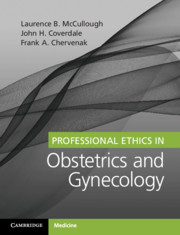Book contents
- Professional Ethics in Obstetrics and Gynecology
- Professional Ethics in Obstetrics and Gynecology
- Copyright page
- Dedication
- Contents
- Preface
- Acknowledgments
- Section 1 Professional Ethics in Obstetrics and Gynecology
- Section 2 Pedagogy of Professional Ethics in Obstetrics and Gynecology
- Section 3 Professionally Responsible Clinical Practice
- Chapter 7 Prevention of Pregnancy
- Chapter 8 Initiation of Pregnancy
- Chapter 9 Induced Abortion and Feticide
- Chapter 10 Fetal Analysis
- Chapter 11 Periviability
- Chapter 12 Intrapartum Management
- Chapter 13 The Perfect Baby
- Chapter 14 Cancer and Pregnancy
- Chapter 15 Setting Ethically Justified Limits on Life-Sustaining Treatment
- Section 4 Professionally Responsible Leadership
- Section 5 Professionally Responsible Innovation and Research
- Section 6 Professionally Responsible Health Policy and Advocacy
- Glossary of Key Concepts
- Index
- References
Chapter 15 - Setting Ethically Justified Limits on Life-Sustaining Treatment
from Section 3 - Professionally Responsible Clinical Practice
Published online by Cambridge University Press: 01 November 2019
- Professional Ethics in Obstetrics and Gynecology
- Professional Ethics in Obstetrics and Gynecology
- Copyright page
- Dedication
- Contents
- Preface
- Acknowledgments
- Section 1 Professional Ethics in Obstetrics and Gynecology
- Section 2 Pedagogy of Professional Ethics in Obstetrics and Gynecology
- Section 3 Professionally Responsible Clinical Practice
- Chapter 7 Prevention of Pregnancy
- Chapter 8 Initiation of Pregnancy
- Chapter 9 Induced Abortion and Feticide
- Chapter 10 Fetal Analysis
- Chapter 11 Periviability
- Chapter 12 Intrapartum Management
- Chapter 13 The Perfect Baby
- Chapter 14 Cancer and Pregnancy
- Chapter 15 Setting Ethically Justified Limits on Life-Sustaining Treatment
- Section 4 Professionally Responsible Leadership
- Section 5 Professionally Responsible Innovation and Research
- Section 6 Professionally Responsible Health Policy and Advocacy
- Glossary of Key Concepts
- Index
- References
Summary
This chapter provides an ethical framework for setting justified limits on life-sustaining treatment.
Sometimes a patient’s condition has deteriorated to such a degree that in deliberative clinical judgment the prediction of imminent death becomes reliable. When death is imminent patients are transferred to a critical care unit in which they receive life-sustaining treatment. Life-sustaining treatment deploys a range of interventions, including physical intervention such as cardiopulmonary resuscitation; intravenous administration of drugs, fluids, and nutrition; and mechanical devices such as circulation devices, extracorporeal membrane oxygenation, dialysis, and ventilators. These interventions are designed to support or replace organ functions in the absence of which the risk of mortality will rapidly approach 100%.
- Type
- Chapter
- Information
- Professional Ethics in Obstetrics and Gynecology , pp. 177 - 188Publisher: Cambridge University PressPrint publication year: 2019



